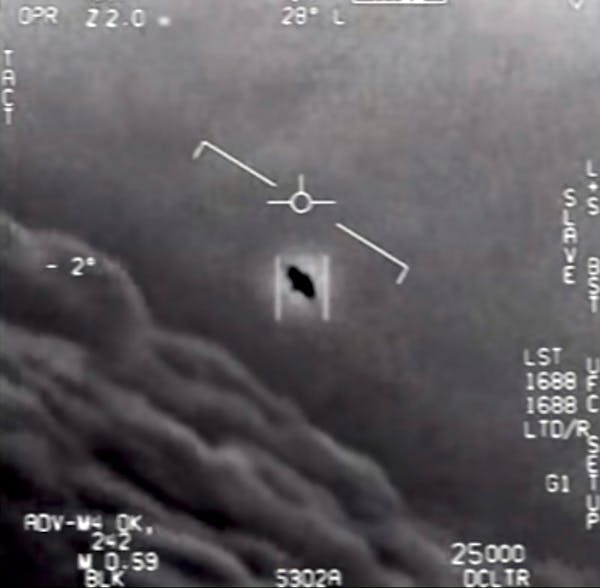This is the month we're supposed to find out more about what in the world (or not-world) the U.S. military and intelligence communities think about those mysterious flying objects we keep hearing about.
The government calls them "unexplained aerial phenomena" — UAP. The common term to the rest of us is UFOs. Either of which could suggest a range of possibilities: Other countries' spying hardware. Or some secretive technological advance that America's left hand doesn't know its right hand has made. Or something that creates the illusion of being more than it is.
Or, to go out on a limb, aliens from outer space.
But just so we're all on the same page, here's the specific thing we seem to be discussing:
"Imagine a technology that can do 6-to-700 G-forces, that can fly at 13,000 miles an hour, that can evade radar and that can fly through air and water and possibly space. And, oh, by the way, has no obvious signs of propulsion, no wings, no control surfaces and yet still can defy the natural effects of Earth's gravity. That's precisely what we're seeing."
Cool.
Unless it turns out to be not cool.
Or not so precise.
The description comes courtesy of Lue Elizondo in a recent episode of "60 Minutes." Elizondo ran military intelligence operations worldwide before being asked to join a Pentagon effort called the Advanced Aerospace Threat Identification Program. His focus was the national security implications of unidentified aerial phenomena.
The "60 Minutes" report augmented others on the subject that have been presented in mainstream media in recent years. The overarching themes are that (1) military pilots are witnessing such phenomena with regularity and (2) people in the government take it seriously.
That trend led the Senate Intelligence Committee to seek details from the defense secretary and the director of national intelligence. The request came about in the usual passive-aggressive congressional way, tucked as it was into last December's 5,500-page omnibus spending bill, the headline item of which was COVID-19 relief. But it seeks data and transparency, and that's never regrettable.
As Sen. Marco Rubio, vice chairman of the Senate's Select Committee on Intelligence, said in the "60 Minutes" report: "I want us to have a process to analyze the data every time it comes in. That there be a place where this is catalogued and constantly analyzed, until we get some answers. Maybe it has a very simple answer. Maybe it doesn't."
The report is due by June 25. There was some talk earlier this year, including from Rubio, that more time may be needed. Better to be out with it, though, even if some aspects must remain classified. An information vacuum is an opportunity for creative narratives to blossom.
What would be most useful? Adam Frank, an astrophysicist, wrote in a recent New York Times commentary that "what a scientist needs are precise measurements from multiple viewpoints provided by devices that register various wavelengths (visual, infrared, radar). That kind of data might tell us if an object's motion required engines or materials that we Earthlings don't possess."
Frank cautioned that "first-person accounts, which are notoriously inaccurate to begin with, don't provide enough information for an empirical investigation" and that "some of the motions seen in the videos (like the ocean skimming) may be artifacts of the cameras' optics and tracking systems."
It's tempting to treat this subject lightly. Something in the vein of: "No space aliens responded to an editorial writer's general telepathic request for clarification." Which is true. They didn't.
Or a cynical response might be that now that there's a branch of the military called the Space Force, it needs activity — and money, too.
But life teaches us that our understanding of our circumstances is always subject to change, and that sometimes the developments can pose a threat. An illuminating report on aerial phenomena would be most welcome.
Cut down on electronic waste in Minnesota
In Minnesota, statistical gloom amid the hope of a progressive-led boom


